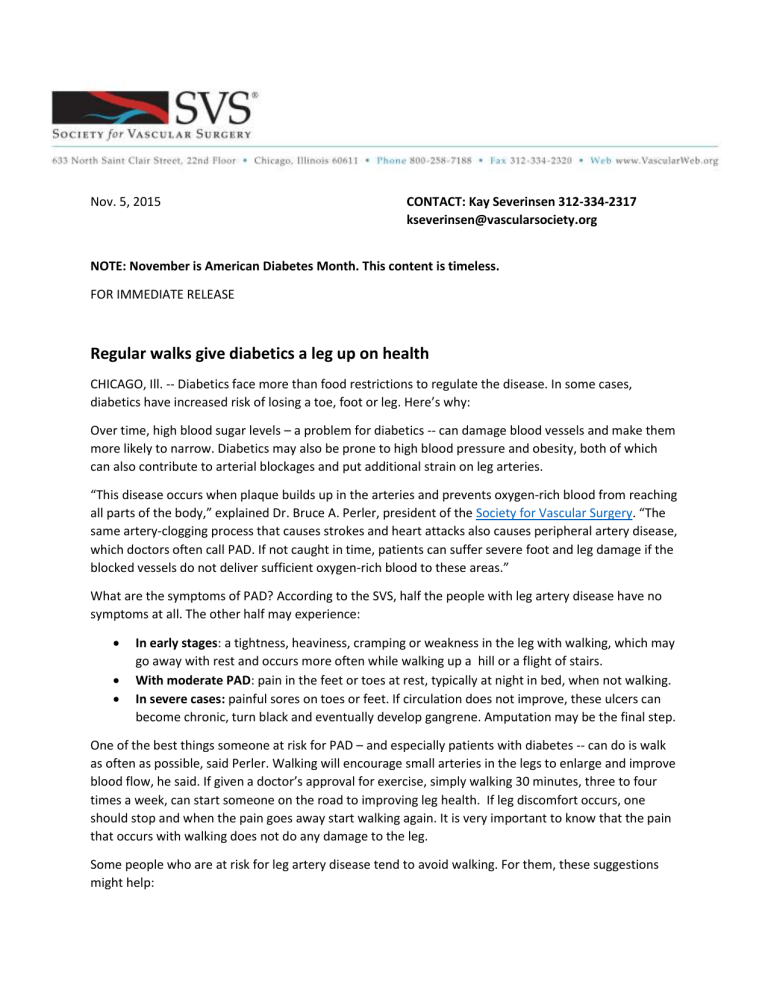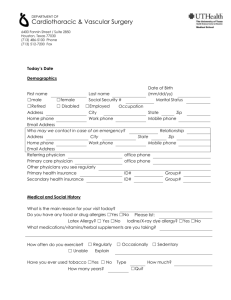Diabetes Month - Regular walks help diabetics 11.5.15

Nov. 5, 2015 CONTACT: Kay Severinsen 312-334-2317 kseverinsen@vascularsociety.org
NOTE: November is American Diabetes Month. This content is timeless.
FOR IMMEDIATE RELEASE
Regular walks give diabetics a leg up on health
CHICAGO, Ill. -- Diabetics face more than food restrictions to regulate the disease. In some cases, diabetics have increased risk of losing a toe, foot or leg. Here’s why:
Over time, high blood sugar levels – a problem for diabetics -- can damage blood vessels and make them more likely to narrow. Diabetics may also be prone to high blood pressure and obesity, both of which can also contribute to arterial blockages and put additional strain on leg arteries.
“This disease occurs when plaque builds up in the arteries and prevents oxygen-rich blood from reaching all parts of the body,” explained Dr. Bruce A. Perler, president of the Society for Vascular Surgery . “The same artery-clogging process that causes strokes and heart attacks also causes peripheral artery disease, which doctors often call PAD. If not caught in time, patients can suffer severe foot and leg damage if the blocked vessels do not deliver sufficient oxygen-rich blood to these areas.”
What are the symptoms of PAD? According to the SVS, half the people with leg artery disease have no symptoms at all. The other half may experience:
In early stages: a tightness, heaviness, cramping or weakness in the leg with walking, which may go away with rest and occurs more often while walking up a hill or a flight of stairs.
With moderate PAD: pain in the feet or toes at rest, typically at night in bed, when not walking.
In severe cases: painful sores on toes or feet. If circulation does not improve, these ulcers can become chronic, turn black and eventually develop gangrene. Amputation may be the final step.
One of the best things someone at risk for PAD – and especially patients with diabetes -- can do is walk as often as possible, said Perler. Walking will encourage small arteries in the legs to enlarge and improve blood flow, he said. If given a doctor’s approval for exercise, simply walking 30 minutes, three to four times a week, can start someone on the road to improving leg health. If leg discomfort occurs, one should stop and when the pain goes away start walking again. It is very important to know that the pain that occurs with walking does not do any damage to the leg.
Some people who are at risk for leg artery disease tend to avoid walking. For them, these suggestions might help:
1.
Schedule regular walks with a friend, neighbor or spouse. Once it’s on the calendar and a buddy is waiting, skipping the appointment is less likely. Some indoor shopping malls offer walking hours, especially when walking might make walking outside difficult.
2.
Have a specific destination. Walk to a park, church or grocery store.
3.
Walkers whose leg starts to hurt during exertion, should stop and rest for a few minutes until the pain eases, then resume walking. Remember, no damage is occurring to the leg when this pain occurs.
4.
If pain is really preventing exercise, it is time to see a vascular specialist who will look at all the options, not just surgery, Perler said. He advised prospective patients to be sure to see someone who is specialized in the treatment of all vascular diseases, and who is board certified in both endovascular and open surgery, in case an intervention is needed.
Find a vascular specialist at this website: http://vsweb.org/FindSpecialist .
The Society for Vascular Surgery® (SVS) is a not-for-profit professional medical society, composed primarily of vascular surgeons, that seeks to advance excellence and innovation in vascular health through education, advocacy, research, and public awareness. SVS is the national advocate for more than 4,500 specialty-trained vascular surgeons and other medical professionals who are dedicated to the prevention and cure of vascular disease. For more information visit http://www.vascularweb.org/ .
##








